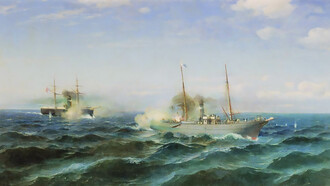Considering the worrying developments of the negotiations between the United States and Russia regarding the Ukraine war, with Kyiv being cornered and scolded by Washington while Russia is being treated with leather gloves, many analysts were eager to make World War Two comparisons, specifically to the Yalta Conference (4th-11th February 1945). I believe that some similitudes are obvious, especially from an Eastern European perspective, as the Western World Powers (the United States and the British Empire) struck a deal with Russia (then the USSR) to split Europe in half and leave Central and Eastern Europe at the hands of the Soviets.
In the end, from that point of view, the ultimate framework of the Conference was the prioritization of world power interests over the needs of smaller, war-torn nations, which makes it obvious why Yalta has such strong reverberations among Eastern Bloc countries and why Ukraine fears this scenario to such an extent.
Despite these similitudes with today’s Washington-Moscow negotiations, it is worth pointing out that there are some clear differences between nowadays and Yalta that might drive one to look for other examples even deeper into the past.
For one, the negotiations were taking place between wartime allies, albeit allies of circumstance, but united against the common enemy represented by Nazi Germany. This is very different from what we are witnessing in 2025, as the United States and Russia were sworn enemies only a few months ago, with the shift happening under the new American administration. Still, the terms and relations in which the negotiations were taking place in Yalta between the different parties were much more positive than nowadays.
Secondly, the core ideas that stood at the basis of the Yalta negotiations were radically different from what we are witnessing today. The US and Britain brought to the table concepts such as the creation of a postwar peacekeeping format, the redrawing of Europe’s borders in a fair manner, and the establishment of democratic structures in countries liberated from German occupation. These discussions between Roosevelt, Churchill, and Stalin ultimately led to the creation of the United Nations, while the border redraw was a partial success, and Stalin ultimately betrayed the promise of allowing democratic movements in Central and Eastern Europe.
Of course, the postwar results radically varied from what Washington and London had in mind during the Yalta Conference, as CEE countries became Soviet satellites. However, the core objectives that the United States and Britain had in mind before Yalta—defending democratic movements, establishing a global forum, and maintaining stability in Europe—stand in complete contrast to Donald Trump’s crusade for “peace” by all means—appeasing an adversarial power to counter a third power (China), diminishing European agency and unity, reducing military spending, and obtaining access to natural resources from one’s allies.
Leaders such as Roosevelt and especially Churchill understood the risk of Soviet expansionism and tried to prevent it to the extent that they could while simultaneously avoiding a devastating consecutive war with the USSR. A subsequent war with the Soviets was nevertheless not fully excluded, as seen in Churchill’s Operation Unthinkable plan.
Meanwhile, the current Washington administration is operating under a quasi-imperialistic framework that is more reminiscent of the 19th-early 20th-century struggles for spheres of influence. This is why it could be useful to explore other deals and negotiations besides Yalta, which might prove to be historically important lessons for the present. One such insightful example, one in which great powers dictate deals and territorial splits to smaller, vulnerable states, could be the less-known Anglo-Russian Convention of 1907.
A model for Imperial dealmaking—the 1907 Anglo-Russian convention
This accord ended a period of tensions between the British and Russian empires, historically known as the “Great Game.” It spread throughout most of the 19th and early 20th century and consisted of a struggle for territory and spheres of influence between London and Moscow in Central and South Asia, without leading to actual military conflict between the two in the region. This historical context is often viewed as a precursor to the Cold War, with parallels to be drawn between how Britain and Russia split their influence in Iran, Afghanistan, and other parts of Central Asia and how the pro-American and pro-Soviet lines were drawn in the second half of the 20th century.
In the end, the two global powers decided to end the Great Game through a convention that would split Iran (among other countries) into spheres of influence. As such, Southern Iran fell under British control, Northern Iran was under Russian tutelage, and its central parts were transformed into a neutral zone. The deal was also struck as a means to counter the ever-increasing influence of the German Empire, which was planning to increase its Middle Eastern influence via the creation of a railroad that would connect Berlin to Baghdad, thus threatening a German-Ottoman collaboration against the Anglo-Russian dominions in Asia. Indeed, the Anglo-Russian treaty was an important first step to the creation of the Triple Entente that would fight in World War I.
The treaty was signed behind Iran’s back, leading to an increase in nationalism and anti-British sentiment, as the population and leaders of Iran viewed this as an act of betrayal. Only a few years before the Anglo-Russian convention, Iran’s liberal and secular forces were gaining traction, even leading to the Shah accepting a constitution and the formation of a parliament. However, this democratization process did not align with British and Russian interests, with the Convention ultimately weakening Iran’s liberal forces and transforming the country into a dominion with no actual agency over its own territory.
Parallels to the Trump-Putin negotiations
Before pointing out some of the parallels that can be made to today’s US-Russia rapprochement, I would like to share a quote by Sir Edward Grey, Britain’s Foreign Minister between 1905 and 1916. To a certain extent, it reflects a similar attitude to that of Donald Trump: risking an increasing Russian influence in Europe in exchange for an alliance against a third party and for a collaboration on the Asian continent. Here is the quote:
If Russia accepts, cordially and whole-heartedly, our intention to preserve the peaceable possession of our Asiatic possessions, then I am quite sure that in this country no government will make it its business to thwart or obstruct Russia's policy in Europe. On the contrary, it is urgently desirable that Russia's position and influence be re-established in the councils of Europe.
If you replace “Asiatic possessions” with “our intention to create an alliance that counterbalances Chinese influence,” then we could see some parallels regarding the tradeoffs that Western powers (in this case the United States) can accept in a Russia negotiation in exchange for increased influence in Asia. Moreover, if we look at the calls for Russia to become an integral part of the European economy again, many coming from Trump-supporting far-right parties in Europe, it can be associated with Grey’s last sentence in the aforementioned quote.
Looking at other parallels, just like Iran in the early 20th century, Ukraine is caught between two world powers, being forced to give up its territory and resources. Just as in the 1907 case, Ukraine was on its way to becoming a full-fledged European democracy, but under the current circumstances, we should not be surprised if we see an increasing anti-American sentiment in Ukraine and possibly a shift towards desperation-driven authoritarianism soon.
Furthermore, this form of simple transactional policymaking that marked the formation of imperial zones of influence in the 19th and early 20th century is very similar to what we are witnessing today, the only difference being the fact that it is not territory per se that is of utmost importance now. Instead, natural resources take the front stage. As we can see in the current declarations made by both the US and Russian presidents, national sovereignty is relative only to the capacity of one country to exert its hard power, while sovereignty over a certain territory or resource can shift based on the Great Powers’ necessities in their global struggles, as one can observe in the case of Trump’s calls for Greenland, Ukraine’s rare earth minerals, or the Panama Canal.
Looking at other parallels, the basis of the 1907 deal countering Germany is very similar to the US’s appeasement of Russia in order to ensure a future alliance against China. The deal the British made paid off, since Imperial Russia played a crucial role in WW1, assuring an attack on Germany on two flanks until the Bolshevik Revolution. It remains to be seen whether Trump’s possible alliance with Putin would be a long-term strategic perk or a blunder, a deception by Moscow, which will try to drag Washington along for as long as possible and ultimately ally with Beijing.
Conclusions
As Monica Duffy Toft from Foreign Affairs states in her piece, “The Ukraine war—and the settlement terms that now appear to be emerging—mark an even more pronounced return to nineteenth-century-style geopolitics in which great powers dictate terms to weaker states.” That is indeed true, as we are witnessing a return to a “might make right” modus operandi and smaller states and territories becoming trading pawns in a global chess game between the great power “grandmasters.”
I believe that it is relevant to look for similarities beyond World War Two and into the colonial era since the simple brutality of dealmaking and the resource grabbing that we are witnessing today remind us of a more distant time. In this context, the current American administration might “have the cards,” as the sitting president often puts it, but it might be outnumbered at the card table.
During the Anglo-Russian Convention, the British Empire was at its peak, while Russia was weakened internally and also affected by a surprising defeat in the 1905 Russo-Japanese War. The British were the ones who ultimately set the tone of the negotiation. Meanwhile, during Yalta, as powerful as the Soviet Union was, it was weakened by a destructive war and was playing two against one against Western democracies. In the current great power alignment, the United States is the sole democracy against two autocracies—Russia and China. It could take a Herculean effort to draw Moscow to the side of Washington in a future conflict—whether military or economic—and if it fails, this could be one of the most hurtful backfires for both global American influence and the stability of the democratic world as a whole.















